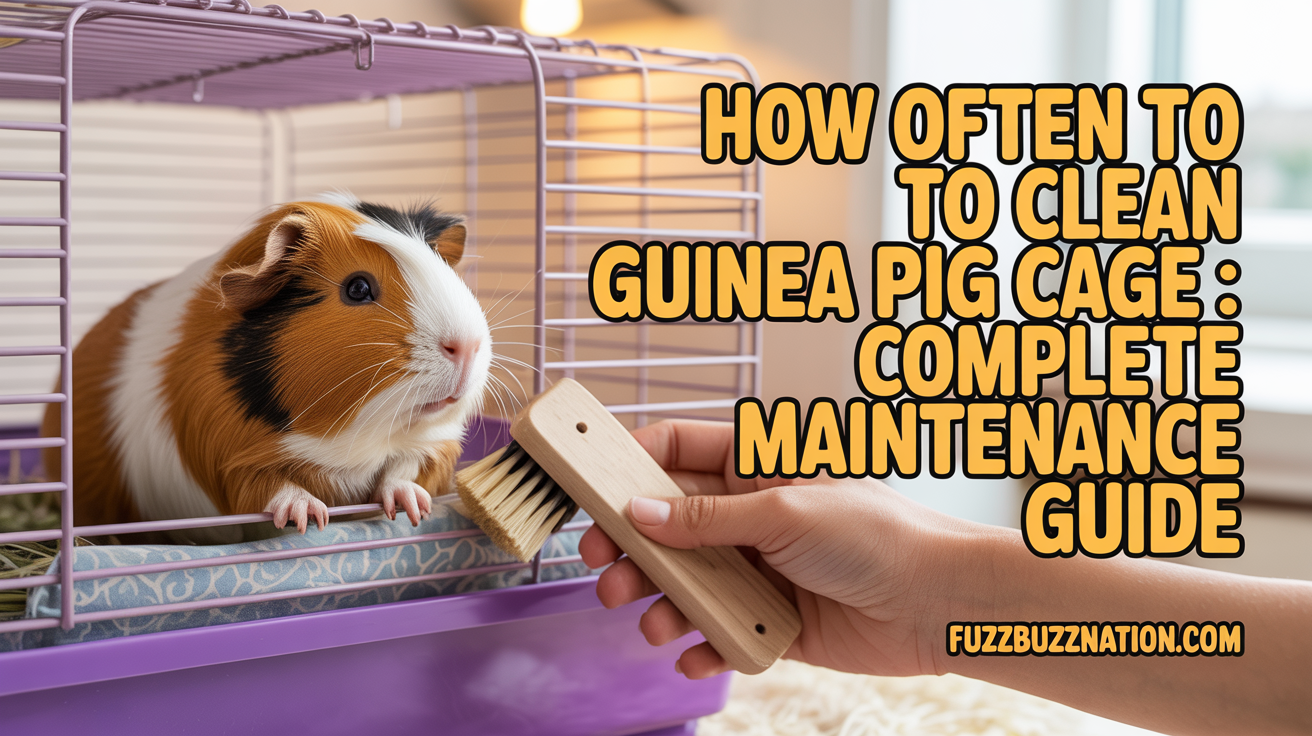
How Often to Clean Guinea Pig Cage: Maintenance Guide
Guinea pig cages require daily spot cleaning to remove soiled bedding and waste, weekly full bedding changes with cage wiping, and monthly deep cleaning involving complete disinfection of all surfaces and accessories. After maintaining guinea pig colonies for over eleven years including breeding operations housing 20+ animals simultaneously, I’ve learned that consistent cage hygiene prevents respiratory infections, skin problems, and odor buildup while significantly improving guinea pig health and lifespan compared to inconsistent or inadequate cleaning schedules.
The key to successful guinea pig cage maintenance lies in establishing sustainable routines that balance thorough cleaning with time efficiency, understanding how bedding type affects cleaning frequency, and recognizing signs that your current schedule needs adjustment based on individual circumstances.
Daily Spot Cleaning Requirements
Daily spot cleaning involves removing visible waste, soiled bedding, and uneaten fresh food that could spoil and attract pests or create unsanitary conditions affecting guinea pig health.
I spend approximately 5-10 minutes daily on spot cleaning tasks, removing wet patches where guinea pigs have urinated, picking up scattered droppings, and replacing heavily soiled areas with fresh bedding material.
High-traffic areas including corners where guinea pigs frequently eliminate, spaces under water bottles where drips accumulate, and feeding zones where food particles scatter require particular attention during daily maintenance.
During my breeding operation, I observed that consistent daily spot cleaning reduced overall cage odor by approximately 70% compared to cages cleaned only during weekly full changes, making the daily time investment worthwhile.
Food bowl cleaning should occur daily, removing uneaten pellets and washing bowls with hot water to prevent bacterial growth from food residue and saliva contamination.
Water bottle maintenance includes daily refilling with fresh water and quick cleaning of bottle tips where algae or food particles can accumulate, affecting water flow and palatability.
Hay rack inspection ensures fresh hay remains available while removing scattered or soiled hay from cage floors where it becomes mixed with bedding and waste materials.
Weekly Full Cleaning Schedule
Complete bedding changes should occur weekly for most guinea pig setups, involving removal of all bedding material, wiping down cage surfaces, and replacing with entirely fresh bedding.
I typically schedule weekly cleanings for the same day each week, establishing routines that make the task habitual rather than requiring constant decision-making about timing.
The process takes approximately 30-45 minutes for standard two-guinea-pig cages, though larger setups or multiple cages naturally require additional time investment.
Fleece liner washing occurs weekly for those using reusable bedding systems, with liners requiring pre-shaking to remove hay and debris before machine washing with pet-safe detergent.
Cage surface wiping with pet-safe cleaners removes accumulated grime, urine residue, and stuck-on debris that builds up even with regular spot cleaning throughout the week.
Accessory cleaning includes washing hideaways, food bowls, and toys with hot soapy water, ensuring all items remain sanitary and free from bacterial or fungal growth.
Corner areas and edges where waste accumulates require scrubbing attention during weekly cleanings, as these spots often harbor stubborn residue that simple wiping doesn’t remove.
Monthly Deep Cleaning Protocol
Deep cleaning involves completely emptying the cage, scrubbing all surfaces with appropriate disinfectants, and allowing thorough drying before reassembling with fresh bedding and accessories.
I use white vinegar diluted 1:1 with water or commercial pet-safe disinfectants for deep cleaning, avoiding harsh chemicals like bleach that can leave dangerous residues or fumes.
Grids, coroplast bases, or cage bars receive thorough scrubbing with appropriate brushes to remove built-up grime in crevices and corners that weekly cleaning doesn’t address completely.
During deep cleaning sessions, I inspect cage components for damage including sharp edges, rust, or deterioration that could injure guinea pigs or compromise cage security.
Accessory inspection and replacement occurs during monthly deep cleaning, identifying worn items needing replacement including frayed hideaways, damaged food bowls, or deteriorating toys.
Floor cleaning beneath and around cages addresses scattered bedding, hay, and debris that accumulates in surrounding areas despite efforts to contain mess within enclosures.
Air quality improvement through deep cleaning significantly benefits guinea pig respiratory health, as ammonia buildup and dust accumulation can cause breathing problems over time.
Bedding Type and Cleaning Frequency
Disposable bedding including paper-based products, aspen shavings, or fleece liners each require different cleaning approaches affecting overall maintenance schedules and time requirements.
Paper bedding absorbs moisture effectively, allowing slightly longer intervals between changes compared to less absorbent materials, though I still recommend weekly full changes minimum.
Through extensive testing with various bedding types, I’ve found that paper-based bedding controls odor better than wood shavings while creating less dust that can irritate guinea pig respiratory systems.
Fleece liners require more frequent spot cleaning as waste sits on surfaces rather than being absorbed, but offer reusability and potential cost savings over disposable options.
Wood shavings need more frequent changes than paper bedding due to inferior absorption and increased dust production, with pine and cedar being completely inappropriate due to respiratory irritants.
Bedding depth affects how quickly full changes become necessary, with 2-3 inches of disposable bedding typically lasting a full week while thinner layers require mid-week refreshing.
Signs Your Cage Needs Cleaning Sooner
Ammonia smell indicates excessive urine accumulation creating respiratory hazards, requiring immediate cleaning regardless of your regular schedule to protect guinea pig health.
I’ve learned to recognize early odor development that signals cleaning needs, as waiting until strong smells develop means guinea pigs have been breathing unhealthy air for extended periods.
Visible wetness beyond small spots suggests inadequate absorbency or overcrowding, requiring either more frequent cleaning, deeper bedding layers, or larger cage space.
Guinea pig behavior changes including reduced activity, reluctance to enter certain cage areas, or excessive grooming may indicate discomfort with cage cleanliness requiring attention.
Fly presence or pest activity signals that waste or food debris has accumulated to problematic levels requiring immediate deep cleaning and schedule adjustment.
Skin irritation or respiratory symptoms in guinea pigs can result from dirty cage conditions, making increased cleaning frequency essential when these health signs appear.
Seasonal factors including summer heat and humidity accelerate bacterial growth and odor development, often requiring more frequent cleaning during warmer months.
Health Implications of Cage Hygiene
Respiratory infections represent the most serious health consequence of poor cage hygiene, developing from ammonia fumes and bacterial growth in soiled bedding.
During my years caring for guinea pigs, I’ve observed direct correlations between inconsistent cage cleaning and increased respiratory problems including sneezing, discharge, and labored breathing.
Bumblefoot (pododermatitis) develops when guinea pigs stand on wet, soiled bedding for extended periods, causing painful foot infections requiring veterinary treatment.
Fungal infections including ringworm thrive in damp, dirty conditions, spreading between cage mates and potentially transmitting to humans through direct contact.
Urinary tract problems can worsen when guinea pigs avoid urinating due to having to stand in soiled areas, leading to bladder issues and potential infections.
Stress levels increase in dirty environments, affecting immune function and making guinea pigs more susceptible to various health problems beyond hygiene-related issues.
Time-Saving Cleaning Strategies
Cage location near cleaning supplies and trash receptacles reduces time spent carrying materials back and forth, making daily spot cleaning more convenient and likely to occur consistently.
I keep dedicated cleaning supplies including handheld vacuums, scoops, and wipes near guinea pig cages, eliminating excuses for skipping daily maintenance due to supply inconvenience.
Litter training in specific cage corners concentrates waste in manageable areas, significantly reducing time needed for spot cleaning throughout the entire cage space.
Multiple cage sets allow rotation where one set can be thoroughly cleaned and dried while guinea pigs occupy the alternate setup, preventing rushed or incomplete cleaning.
Efficient workflows including assembling supplies before starting, working systematically through cleaning steps, and using appropriate tools significantly reduce time requirements.
Partner or family involvement through task delegation spreads workload, making guinea pig care more sustainable for busy households while teaching responsibility to children.
Optimal Cleaning Products and Tools
White vinegar provides safe, effective cleaning power for routine maintenance, breaking down urine residue and controlling odors without leaving dangerous chemical residues.
Pet-safe enzymatic cleaners specifically designed for small animals offer superior odor control compared to general household cleaners that may contain harmful ingredients.
I avoid ammonia-based cleaners as they can confuse guinea pigs into marking areas more heavily, and their fumes are particularly dangerous for small animals with sensitive respiratory systems.
Handheld vacuums or small shop vacuums efficiently remove scattered hay, bedding, and droppings from cage surfaces and surrounding areas without requiring broom and dustpan coordination.
Cage liners or washable pads placed under disposable bedding protect cage bases from staining and make full cleaning easier by preventing direct contact between waste and surfaces.
Scrub brushes with appropriate stiffness remove stuck-on debris without damaging cage materials, with separate brushes designated exclusively for guinea pig cage cleaning.
Bedding Disposal and Environmental Considerations
Soiled guinea pig bedding can be composted if using paper or wood-based products, creating garden fertilizer while reducing landfill waste from pet care activities.
I maintain designated compost bins for guinea pig waste separate from kitchen compost, as pet waste requires appropriate decomposition before use on food-producing plants.
Biodegradable bag usage for bedding disposal reduces environmental impact compared to standard plastic bags, though bags must be sturdy enough to handle weight without tearing.
Recycling considerations for paper-based bedding depend on local guidelines, as animal waste contamination may prevent recycling acceptance in some municipalities.
Volume reduction through compacting soiled bedding before disposal decreases trash bag usage and reduces storage space needed for waste between collection days.
Seasonal Cleaning Adjustments
Summer humidity and heat accelerate bacterial growth and odor development, often requiring mid-week partial bedding changes in addition to standard weekly full cleaning.
During my experience managing guinea pigs through various climates, I’ve found that summer cleaning frequency sometimes needs to increase by 30-50% compared to winter schedules.
Winter heating systems dry out cage environments, potentially allowing slightly longer intervals between changes, though I maintain weekly full cleaning regardless of season.
Spring cleaning represents an ideal time for thorough cage assessment, replacing worn equipment and evaluating whether current cleaning schedules and products remain effective.
Holiday periods requiring travel away from home necessitate either arranging knowledgeable caretakers who understand cleaning requirements or adjusting schedules before and after trips.
Multi-Guinea Pig Considerations
Additional guinea pigs increase waste production proportionally, requiring either more frequent cleaning or larger cages that distribute waste across greater surface area.
I’ve observed that doubling guinea pig numbers doesn’t precisely double cleaning time due to efficiency gains, though it does increase time requirements by approximately 60-75%.
Gender differences affect waste patterns, with boars often creating more concentrated urine areas while sows distribute waste more evenly throughout cage space.
Compatibility issues between cage mates can create stress that increases elimination frequency, requiring cleaning schedule adjustments beyond what population alone would suggest.
Age factors including young guinea pigs and seniors may affect waste patterns, with elderly animals sometimes developing incontinence requiring additional cleaning attention.
Common Cleaning Mistakes to Avoid
Insufficient rinsing after using cleaning products can leave residues that irritate guinea pig respiratory systems or skin, making thorough rinsing essential for health safety.
I’ve worked with owners whose guinea pigs developed respiratory problems from inadequate rinsing of cleaning products, illustrating the importance of complete product removal.
Over-cleaning through excessive chemical use or too-frequent disinfection can stress guinea pigs through constant environmental disruption and exposure to cleaning product fumes.
Incomplete drying before replacing guinea pigs in cages creates damp conditions promoting bacterial growth and potentially causing chills in animals placed in wet environments.
Neglecting surrounding areas allows bacterial growth and pest attraction in spaces around cages where scattered materials accumulate without regular cleaning attention.
Inconsistent scheduling creates unpredictable cleaning patterns that often result in delayed maintenance and degraded cage conditions affecting guinea pig health.
Special Circumstances Requiring Schedule Changes
Illness in guinea pigs may require increased cleaning frequency to support recovery while preventing disease spread to healthy cage mates through contaminated environments.
New guinea pig introductions increase stress that can elevate elimination frequency temporarily, requiring closer monitoring and potentially more frequent cleaning during adjustment periods.
Pregnancy and nursing periods create additional hygiene needs as mothers require pristine environments for safe delivery and healthy baby development.
Post-surgery care often includes specific cleaning recommendations from veterinarians, requiring temporary schedule modifications that support healing while preventing infection.
Respiratory illness outbreaks necessitate immediate deep cleaning and increased maintenance frequency until all animals recover completely from infections.
Building Sustainable Cleaning Routines
Habit formation through consistent daily spot cleaning at the same time each day makes the task automatic, requiring less mental energy to maintain over long periods.
I schedule my guinea pig cleaning during existing daily routines like morning coffee or evening relaxation, piggybacking on established habits to ensure consistency.
Time tracking initial cleaning sessions helps establish realistic expectations about time requirements, preventing discouragement from underestimating actual cleaning duration.
Gradual efficiency improvements occur naturally as cleaning routines become familiar, with experienced owners completing tasks significantly faster than beginners.
Backup plans for busy or sick days ensure cleaning continues even when primary caregivers face obstacles, protecting guinea pig health during temporary disruptions.
Cost Considerations for Cage Maintenance
Bedding expenses represent ongoing costs ranging from $20-50 monthly depending on bedding type, guinea pig numbers, and whether reusable or disposable options are chosen.
Cleaning supply costs including brushes, vinegar, and enzymatic cleaners typically add $10-20 monthly to maintenance budgets for well-stocked cleaning stations.
I’ve calculated that fleece liner systems cost more initially but save approximately 40% long-term compared to disposable bedding over a guinea pig’s 5-7 year lifespan.
Time investment calculations valuing personal time help assess whether premium disposable bedding or reusable systems offer better overall value for individual situations.
Bulk purchasing of preferred bedding and cleaning supplies reduces per-unit costs while ensuring adequate supplies remain available without last-minute shopping trips.
Frequently Asked Questions
Can I clean my guinea pig cage less often if I use more bedding?
While deeper bedding absorbs more waste before saturation, weekly full cleaning remains necessary regardless of bedding depth due to ammonia buildup, bacterial growth, and hygiene concerns that thick bedding doesn’t prevent. Daily spot cleaning is still essential even with extra bedding, as surface waste and soiled areas require removal to maintain healthy conditions. Deeper bedding may extend time before odor becomes noticeable, but this doesn’t mean the environment is healthier for your guinea pigs.
What’s the best bedding type for reducing cleaning frequency?
Paper-based bedding like Carefresh offers the best combination of absorption, odor control, and safety, though even with premium bedding, weekly full changes remain necessary. Fleece liners are reusable but require more frequent spot cleaning as waste sits on surfaces. No bedding type eliminates the need for consistent weekly cleaning, though quality bedding makes the process easier and controls odor better between full changes.
How do I clean my guinea pig cage if I work full-time?
Daily spot cleaning takes only 5-10 minutes and can be done morning or evening around work schedules. Reserve weekly full cleaning for weekends or days off when you have 30-45 minutes available. Many working owners successfully maintain guinea pigs by establishing consistent routines that become quick, habitual tasks rather than lengthy projects. Consider enlisting family members to help or using fleece liners that can be quickly changed and washed.
Is it safe to use bleach to clean guinea pig cages?
Bleach can be used if heavily diluted (1:10 ratio) and thoroughly rinsed, but white vinegar or pet-safe enzymatic cleaners are safer, equally effective alternatives. Bleach fumes can irritate guinea pig respiratory systems, and any residue left after inadequate rinsing poses serious health risks. If using bleach, ensure complete drying and thorough rinsing before returning guinea pigs to cleaned cages. Most guinea pig care experts recommend avoiding bleach in favor of safer alternatives.
How often should I completely replace fleece cage liners?
Wash fleece liners weekly, but the liners themselves typically last 6-12 months with proper care before requiring replacement due to wear. Have at least two sets of liners to rotate, allowing one set to be washed while the other is in use. Pre-shake liners to remove debris before washing, use pet-safe detergent without fabric softener, and hang dry or use low dryer heat to extend liner life and maintain absorption.
Creating Your Personalized Cleaning Schedule
Assess your specific situation including guinea pig numbers, cage size, bedding type, and available time to create realistic cleaning schedules you can maintain consistently.
Document your initial schedule and adjust based on actual experience, noting when odors develop, how quickly bedding becomes saturated, and what time requirements actually occur.
Build flexibility into plans acknowledging that some weeks require extra cleaning while others might allow slight extension, though never compromise daily spot cleaning or exceed two weeks without full changes.
Evaluate results monthly by assessing guinea pig health, home odor levels, and your own sustainability maintaining the schedule before making permanent adjustments.
Remember that consistent adequate cleaning prevents expensive veterinary bills and improves guinea pig quality of life, making time invested in proper cage hygiene worthwhile for both animal welfare and owner satisfaction.
The goal is establishing sustainable routines that maintain healthy environments for your guinea pigs while fitting realistically into your lifestyle, creating a balance between thorough care and practical long-term sustainability.


